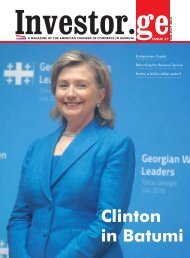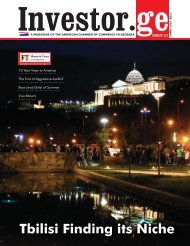Issue 1, 2013 February-March - Investor.ge
Issue 1, 2013 February-March - Investor.ge
Issue 1, 2013 February-March - Investor.ge
- No tags were found...
You also want an ePaper? Increase the reach of your titles
YUMPU automatically turns print PDFs into web optimized ePapers that Google loves.
Based on data from November2012, ISET PI has released itsnext forecasts for Georgia’sreal GDP growth rates. The forecast forthe last quarter of 2012 dropped furtherdown and the final number stands at6.2% . This reduction was not, however,enough to chan<strong>ge</strong> the annual forecast forthe whole of 2012, which stays at thelevel of 7.2%. In the meantime, the forecastfor the 1st quarter of <strong>2013</strong> has alsobeen reduced and now stands at 6.2%.Quickly summarizing last year(2012), we can say that it was a successfulyear for Georgia in terms ofeconomic growth. The country exceededthe expectations (6.0% annual growth)of the World Bank by maintaining anannual growth rate at nearly the level(7.0%) of 2011. Even if the growth rateof the last quarter of 2012 turns out to beless than the forecasted 6.2%, the annualgrowth rate level of 2012 will still beclose to 7.0%.At the same time, Georgia bestedits neighboring countries. If we look atthe table, Georgia’s growth rates clearlystand out.2012 was election year in Georgiaand the government chan<strong>ge</strong>d as a resultof those elections. Naturally, these politicalshocks influenced the performance ofthe Georgian economy. The pre-electionperiod was characterized by oversizedgovernmental expenses, mainly on roadinfrastructure, which resulted in lar<strong>ge</strong>growth rates (varying around 20-25%) inthe construction sector. However, therewere also high growth rates in sectorslike manufacture (around 20%) andfinancial activity (15%), which indicatesustainable growth.The growth started relatively slowlyin the 1st quarter (growth rate 6.7%)and rose to 8.2% in the 2nd quarter.It went down again in the 3rd quarter,which culminated in the pre-electoralcampaign, to stand at 7.5%. However,economic activity also slowed down inthe 3rd quarter in the countries neighboringGeorgia: Russia’s GDP grew onlyby 2.9% (y-on-y) in the 3rd quarter; theTurkish economy almost did not grow atall in that quarter (a growth rate of only0.2%), and Ukraine even experienced adrop of 1.3%.The 4th quarter of 2012 coincidedwith the post-electoral period and, giventhe chan<strong>ge</strong> of government, political uncertaintiesstemming from the politicaltransition influenced this period. Demandon money, the growth of VAT turnover,and external trade (both imports andexports) decreased during the quarter,which indicates a decline in economicactivity. The new government started todecrease governmental expenses, whichmight slow down economic growth inthe short-term. However, this decreasewas lar<strong>ge</strong>ly caused by an optimization ofgovernmental expenses and the reductionof “other expenses” by 50%. This willincrease the country’s fiscal transparencyand is good for the future.Our forecasting model is based on theLeading Economic Indicator (LEI) methodologydeveloped by the New EconomicSchool 2. We constructed a dynamicmodel of the Georgian economy whichassumes that all economic variables,including the GDP itself, are driven bya small number of factors, that can beextracted from the data well before theGDP growth estimates are published. Foreach quarter, ISET-PI produces five consecutivemonthly forecasts (“vinta<strong>ge</strong>s”),which increase in precision as time goeson. Our first forecast (1st vinta<strong>ge</strong>) isavailable about five months before theend of the quarter in question. The lastforecast (5th vinta<strong>ge</strong>) is published in thelast month of the quarter.







